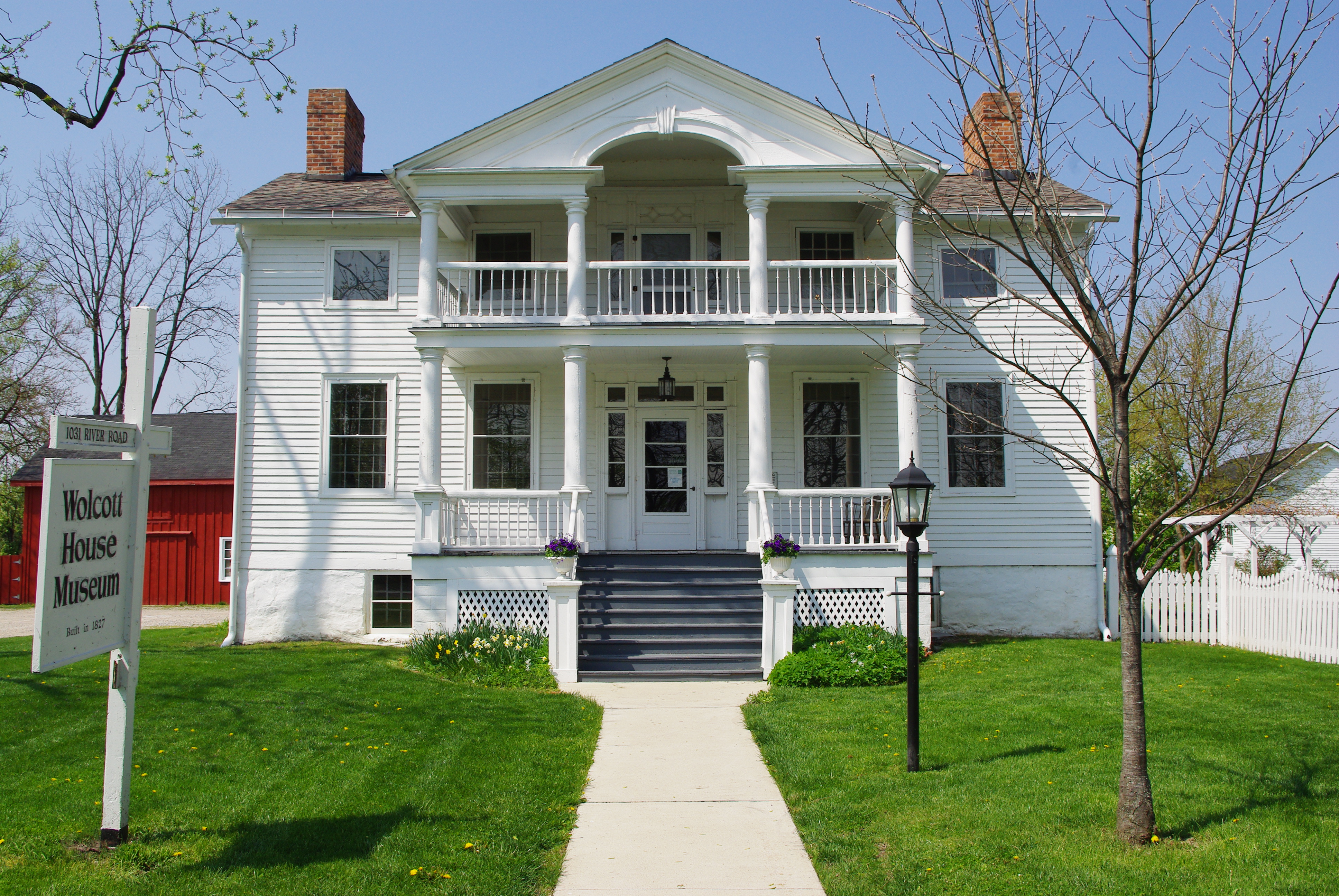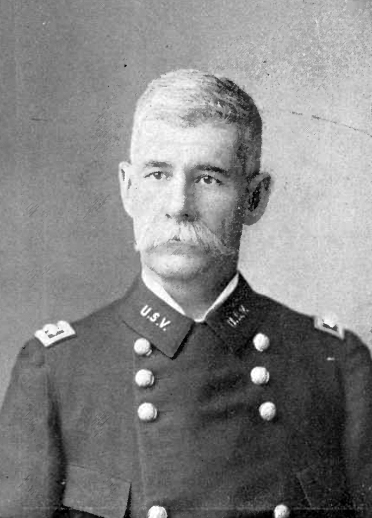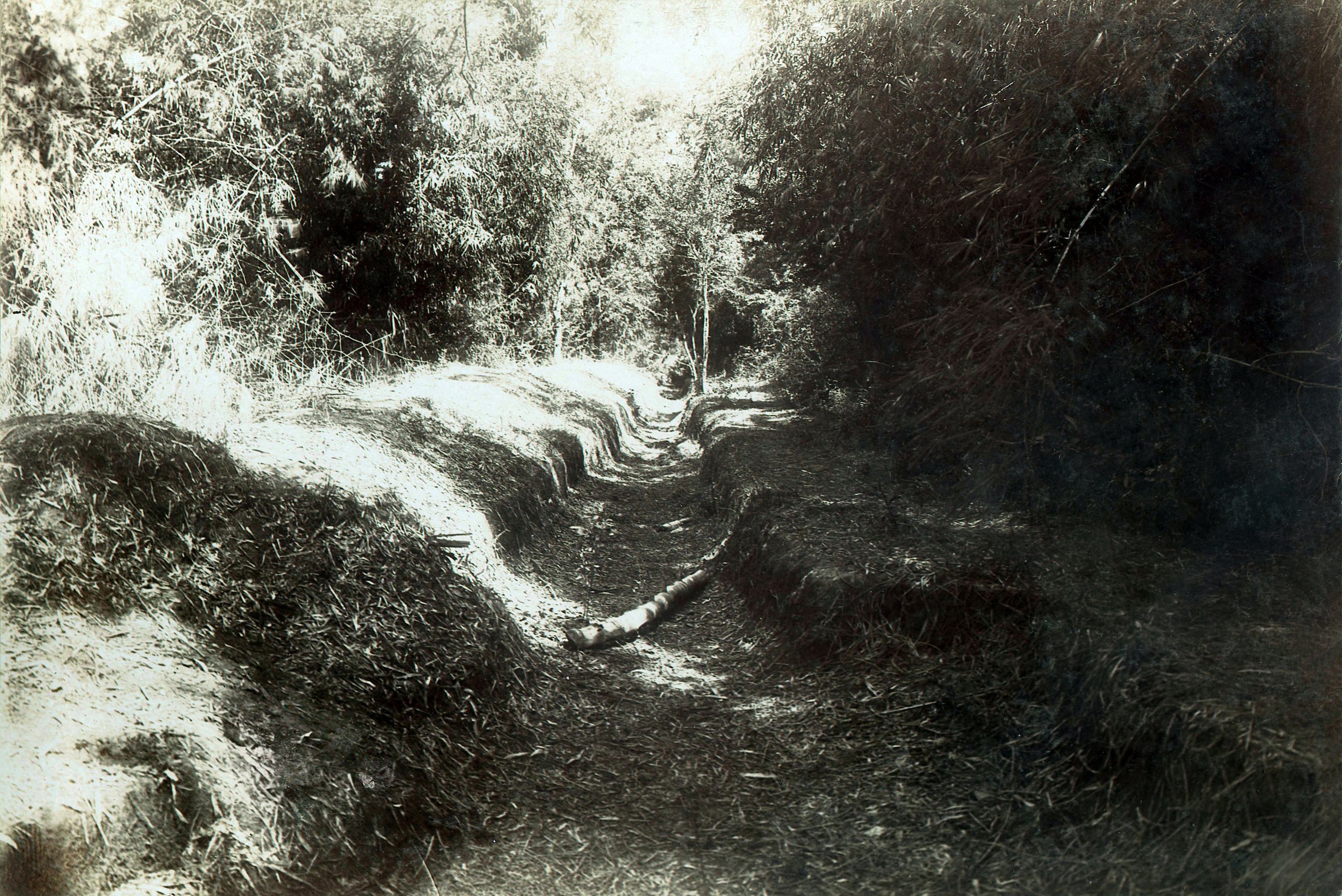|
Henry W. Lawton
Henry Ware Lawton (March 17, 1843 – December 19, 1899) was a U.S. Army officer who served with distinction in the Civil War, the Apache Wars, and the Spanish–American War. He was the only U.S. general officer to be killed during the Philippine–American War and the first general officer of the United States killed in overseas action. The city of Lawton, Oklahoma, takes its name from General Lawton, as does a borough in the city of Havana, Cuba. Liwasang Bonifacio (Bonifacio Square) in downtown Manila was formerly named Plaza Lawton in his honor. Early life Lawton was born on March 17, 1843, in Maumee, Ohio. He was the son of millwright George W. Lawton and Catherine (née Daley) who had been married in December 1836. Henry had two brothers, George S. and Manley Chapin. In 1843, Lawton's father moved to Fort Wayne, Indiana, to work on a mill. The family followed him the same year. George went to California in 1850 to build shakers for the gold miners. He returned to Ft. Wayn ... [...More Info...] [...Related Items...] OR: [Wikipedia] [Google] [Baidu] |
Maumee, Ohio
Maumee ( ) is a city in Lucas County, Ohio, United States. Located along the Maumee River, it is about 10 miles southwest of Toledo. The population was 14,286 at the 2010 census. Maumee was declared an All-America City by the National Civic League in June 2006. Geography Maumee is located at (41.570545, -83.652503). It is about 11 miles upriver of Toledo, which is at the mouth of the Maumee River on Maumee Bay. This is a roughly triangle-shaped city. Its borders are formed by Interstate 80/ 90 to the north, to the west by Interstate 475/U.S. Route 23, and to the southeast by the Maumee River. It is just downriver from Waterville. According to the United States Census Bureau, the city has a total area of , of which is land and is water. History In pre-colonial times, Native Americans (notably the Ottawa) began using the rich resources at the present site of Maumee, Ohio, in the Maumee River valley. Throughout much of the eighteenth century, French, British and America ... [...More Info...] [...Related Items...] OR: [Wikipedia] [Google] [Baidu] |
Lawton, Oklahoma
Lawton is a city in and the county seat of Comanche County, in the U.S. state of Oklahoma Oklahoma (; Choctaw language, Choctaw: ; chr, ᎣᎧᎳᎰᎹ, ''Okalahoma'' ) is a U.S. state, state in the South Central United States, South Central region of the United States, bordered by Texas on the south and west, Kansas on the nor .... Located in southwestern Oklahoma, approximately southwest of Oklahoma City, it is the principal city of the Lawton metropolitan area, Lawton, Oklahoma, metropolitan statistical area. According to the 2020 United States Census, 2020 census, Lawton's population was 90,381, making it the sixth-largest city in the state, and the largest in Western Oklahoma. Developed on former Indian reservation, reservation lands of the Kiowa, Comanche, and Fort Sill Apache Tribe, Apache Indians, Lawton was founded by European Americans on 6 August 1901. It was named after Major General Henry Ware Lawton, who served in the Civil War, where he earned the M ... [...More Info...] [...Related Items...] OR: [Wikipedia] [Google] [Baidu] |
Medal Of Honor
The Medal of Honor (MOH) is the United States Armed Forces' highest military decoration and is awarded to recognize American soldiers, sailors, marines, airmen, guardians and coast guardsmen who have distinguished themselves by acts of valor. The medal is normally awarded by the president of the United States, but as it is presented "in the name of the United States Congress", it is sometimes erroneously referred to as the "Congressional Medal of Honor". There are three distinct variants of the medal: one for the Department of the Army, awarded to soldiers, one for the Department of the Navy, awarded to sailors, marines, and coast guardsmen, and one for the Department of the Air Force, awarded to airmen and guardians. The Medal of Honor was introduced for the Department of the Navy in 1861, soon followed by the Department of the Army's version in 1862. The Department of the Air Force used the Department of the Army's version until they received their own distinctive version i ... [...More Info...] [...Related Items...] OR: [Wikipedia] [Google] [Baidu] |
Battle Of Paye
The Battle of Paye was a battle during the Philippine–American War between the United States and the Philippines. It was fought on January 31, 1900, at Sitio Paye near Barangay Balimbing in the town of Boac, Marinduque , officially the ( tgl, Bayan ng Boac; ceb, Lungsod sa Boac), is a and capital of the province of , . According to the , it has a population of people making the Most populous town in Marinduque. Situated in the western coast of Marindu .... The short skirmish happened between the reconnaissance forces of Company A, 29th USV under the command of 1st Lieutenant Willam S. Wells and the guerrila forces of the 2nd Guerilla under the command of Captain Teofilo Navaroso Roque. References {{DEFAULTSORT:Paye, battle of Battles of the Philippine–American War History of Marinduque 1900 in the Philippines July 1900 events Conflicts in 1899 ... [...More Info...] [...Related Items...] OR: [Wikipedia] [Google] [Baidu] |
Battle Of Zapote Bridge
The Battle of Zapote River ( fil, Labanan sa Ilog ng Zapote, es, Batalla de Rio de Zapote), also known as the Battle of Zapote Bridge, was fought on the 13 June 1899 between 1,200 Americans and between 4,000~5,000 Filipinos.U.S. War Dept (1900), pg 282. It was the second largest battle of the Philippine–American War after the Battle of Manila five months before in February 1899. Zapote River separates the town of Las Piñas in what was then Manila province from Bacoor in the province of Cavite. The ruins of Zapote Bridge still stands next to its replacement bridge on Aguinaldo Highway. Zapote Bridge Zapote Bridge was made of masonry, spanning the Zapote River. It connected the towns of Bacoor and Imus to the south and Las Piñas and Manila to the north. It has been witness to two major historical events; the Philippine revolution against Spain in 1897 and the Philippine–American War of 1899. Half of the original Zapote Bridge was destroyed during the battles; thus, the l ... [...More Info...] [...Related Items...] OR: [Wikipedia] [Google] [Baidu] |
Battle Of Santa Cruz (1899)
This Battle of Santa Cruz was a battle fought in the early stages of the Philippine–American War during General Henry W. Lawton's Laguna de Bay campaign. Background After defeating the Filipino nationalists at the second battle of Manila, General Elwell S. Otis, commander of the US VIII Corps, sent the 1st Division under Arthur MacArthur to the north to threaten the Filipino capitol at Malolos. At the same time, the 2nd Division under Henry W. Lawton was sent south into the Laguna province, to the Filipino stronghold located in the town of Santa Cruz.. Landings On April 8, 1899, Lawton's division boarded a small fleet of ''cascos'' escorted by the gunboats ''Laguna de Bay'', ''Oeste'' and ''Napindan'', on the Pasig River east of Manila and sailed towards Laguna de Bay. The flotilla did not reach the opposite shore of the lake until early afternoon the next day, because the pilots were unfamiliar with the river and frequently grounded the boats. At 10:30 a.m. on April ... [...More Info...] [...Related Items...] OR: [Wikipedia] [Google] [Baidu] |
Philippine–American War
The Philippine–American War or Filipino–American War ( es, Guerra filipina-estadounidense, tl, Digmaang Pilipino–Amerikano), previously referred to as the Philippine Insurrection or the Tagalog Insurgency by the United States, was an armed conflict between the First Philippine Republic and the United States that started on February 4, 1899, and ended on July 2, 1902. The conflict arose in 1898 when the United States, rather than acknowledging the Philippines' Philippine Declaration of Independence, declaration of independence, annexed the Philippines under the Treaty of Paris (1898), Treaty of Paris at the conclusion of the Spanish–American War. The war can be seen as a continuation of the Philippine struggle for independence that began in 1896 with the Philippine Revolution against Spanish East Indies, Spanish rule. Fighting erupted between forces of the United States and those of the Philippine Republic on February 4, 1899, in what became known as the Battle of Manila ... [...More Info...] [...Related Items...] OR: [Wikipedia] [Google] [Baidu] |
Siege Of Santiago
The siege of Santiago, also known as the siege of Santiago de Cuba, was the last major operation of the Spanish–American War on the island of Cuba. Santiago campaign The primary objective of the American Fifth Army Corps' invasion of Cuba was the capture of the city of Santiago de Cuba. U.S. forces had driven back the Spaniards' first line of defense at the Battle of Las Guasimas, after which General Arsenio Linares pulled his troops back to the main line of defense against Santiago along San Juan Heights. In the charge at the Battle of San Juan Hill U.S. forces captured the Spanish position. At the Battle of El Caney the same day, U.S. forces took the fortified Spanish position and were then able to extend the U.S. flank on San Juan Hill. The destruction of the Spanish fleet at the Battle of Santiago de Cuba allowed U.S. forces to safely besiege the city. Siege On July 3, 1898, the same day as the naval battle, Major General William "Pecos Bill" Shafter began the sieg ... [...More Info...] [...Related Items...] OR: [Wikipedia] [Google] [Baidu] |
Battle Of El Caney
The Battle of El Caney was fought on July 1, 1898, during the Spanish-American War. 600 Spanish soldiers held for twelve hours, until they ran out of ammunition, against Henry W. Lawton's 5th US Division, made up of 6,899 men. This action temporarily delayed the American advance on the San Juan Hills, as had been requested of General William Rufus Shafter.Nofi, A.A., 1996, ''The Spanish–American War, 2020'', Pennsylvania: Combined Books, Nevertheless, American forces advanced on San Juan Hill the same day. Though encountering spirited resistance similar to ''El Caney'', the Americans were ultimately victorious, culminating in the capitulation of the Spanish garrison. Background At El Caney, Cuba, 514 Spanish regular soldiers, together with approximately 100 armed Spanish and Cubans loyal to SpainOssad, Steven L., ''Henry Ware Lawton: Flawed Giant and Hero of Four Wars'', Army History (Winter 2080), p. 13 under the command of Brigadier General Joaquín Vara de Rey y Rubio we ... [...More Info...] [...Related Items...] OR: [Wikipedia] [Google] [Baidu] |
Battle Of Las Guasimas
The Battle of Las Guasimas of June 24, 1898 was a Spanish rearguard action by Major General Antero Rubín against advancing columns led by Major General "Fighting Joe" Wheeler and the first land engagement of the Spanish–American War. The battle unfolded from Wheeler's attempt to storm Spanish positions at Las Guasimas de Sevilla, in the jungles surrounding Santiago de Cuba, with the 1st U.S. Volunteer Cavalry and the 10th Regular Cavalry. Approaching on June 24, American reports suggested the Spaniards were digging in with a field gun; however, Cuban scouts contradicted these, revealing the Spaniards were preparing to abandon their position. In fact, the Spanish troops had received orders to fall back on Santiago. Wheeler requested the assistance of the attached Cuban forces in an immediate attack, but their commander, Col. Gonzales Clavel, refused. Wheeler decided to attack anyway, rushing his men forward with two field guns in tow. During the excitement of the battle, W ... [...More Info...] [...Related Items...] OR: [Wikipedia] [Google] [Baidu] |
Spanish–American War
, partof = the Philippine Revolution, the decolonization of the Americas, and the Cuban War of Independence , image = Collage infobox for Spanish-American War.jpg , image_size = 300px , caption = (clockwise from top left) , date = April 21 – August 13, 1898() , place = , casus = , result = American victory *Treaty of Paris (1898), Treaty of Paris of 1898 *Founding of the First Philippine Republic and beginning of the Philippine–American War * German–Spanish Treaty (1899), Spain sells to Germany the last colonies in the Pacific in 1899 and end of the Spanish Empire in Spanish colonization of the Americas, America and Asia. , territory = Spain relinquishes sovereignty over Cuba; cedes Puerto Rico, Guam and the Philippine Islands to the United States. $20 million paid to Spain by the United States for infrastructure owned by Spain. , combatant1 = United State ... [...More Info...] [...Related Items...] OR: [Wikipedia] [Google] [Baidu] |






